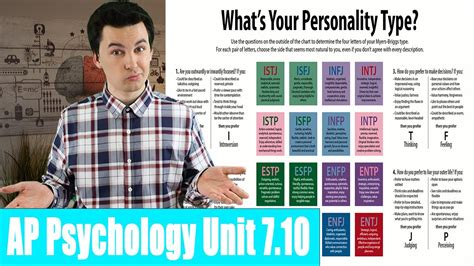Introduction
Personality is a complex and multifaceted construct that has been the subject of extensive research in psychology. It refers to the unique and relatively stable patterns of thoughts, feelings, and behaviors that characterize an individual. AP Psych Unit 7 delves into the various theories and perspectives on personality, providing students with a comprehensive understanding of this fundamental aspect of human psychology.

Psychodynamic Theories
Sigmund Freud’s Psychoanalytic Theory:
- Proposes that personality is shaped by unconscious conflicts between innate drives and social constraints.
- The id, ego, and superego represent the id, ego, and superego, respectively, and their interactions determine personality.
- Early childhood experiences have a profound impact on personality development.
Humanistic Theories
Carl Rogers’ Person-Centered Theory:
- Emphasizes the importance of self-concept, self-actualization, and unconditional positive regard.
- Individuals have the innate capacity to grow and develop their full potential.
- Therapy focuses on creating a supportive and accepting environment.
Trait Theories
Raymond Cattell’s 16 Personality Factor Model (16PF):
- Identifies 16 primary personality traits that encompass a wide range of human characteristics.
- Uses statistical analysis to assess individuals on these traits.
- Provides a comprehensive and objective measure of personality.
Transactional Theories:
Albert Bandura’s Social Cognitive Theory:
- Focuses on the reciprocal relationship between personality, environment, and behavior.
- Individuals learn and acquire personality traits through observation, imitation, and reinforcement.
- Self-efficacy, or the belief in one’s ability to accomplish tasks, plays a significant role in personality.
Assessment of Personality:
MMPI-2 (Minnesota Multiphasic Personality Inventory-2):
- The most widely used personality assessment tool.
- Consists of over 500 statements that individuals respond to based on their experiences and feelings.
- Provides a comprehensive profile of personality strengths, weaknesses, and potential clinical concerns.
Personality Disorders:
Diagnostic and Statistical Manual of Mental Disorders (DSM-5):
- Provides diagnostic criteria for various personality disorders.
- Disorders are characterized by inflexible and impairing personality traits that cause significant distress or dysfunction.
- Examples include antisocial, borderline, and narcissistic personality disorders.
Applications of Personality Psychology:
-
Clinical Psychology:
- Diagnosis and treatment of personality disorders
- Identifying risk factors and protective factors for mental illness
- Developing therapeutic interventions tailored to individual personalities
-
Organizational Psychology:
- Recruiting and selecting employees for specific job roles
- Creating effective teams and optimizing workplace performance
- Developing leadership programs and promoting employee growth
-
Education:
- Understanding individual learning styles and adapting teaching methods
- Creating supportive and inclusive learning environments
- Promoting self-awareness and emotional intelligence in students
Current Trends and Future Directions:
- Increasing use of neuroimaging techniques to explore the biological basis of personality
- Development of new assessment tools that incorporate technology and artificial intelligence
- Integration of personality research with other fields, such as genetics and neuroscience
- Exploration of the role of personality in areas such as health, relationships, and decision-making
Tables:
Table 1: Psychodynamic Defense Mechanisms
| Defense Mechanism | Description |
|---|---|
| Repression | Unconsciously pushing unacceptable thoughts or feelings out of awareness |
| Projection | Attributing one’s own unacceptable thoughts or feelings to others |
| Rationalization | Creating logical but false explanations for unacceptable behaviors |
| Sublimation | Directing unacceptable impulses into socially acceptable channels |
| Reaction Formation | Expressing the opposite of unacceptable thoughts or feelings |
Table 2: Humanistic Personality Characteristics
| Characteristic | Description |
|---|---|
| Self-Concept | The individual’s perception of their own identity, worthiness, and limitations |
| Self-Actualization | The striving to fulfill one’s full potential and become the best version of themselves |
| Unconditional Positive Regard | Offering love and acceptance to others without judgment or conditions |
Table 3: Trait Theory Personality Dimensions
| Dimension | Description |
|---|---|
| Extraversion | Sociable, outgoing, and energetic |
| Agreeableness | Friendly, compassionate, and trusting |
| Conscientiousness | Organized, reliable, and goal-oriented |
| Neuroticism | Anxious, emotional, and prone to negative thoughts |
| Openness to Experience | Imaginative, artistic, and receptive to new ideas |
Table 4: Applications of Personality Psychology
| Application | Description |
|---|---|
| Clinical Psychology | Diagnosis and treatment of personality disorders, improving mental health |
| Organizational Psychology | Enhancing workplace performance, optimizing employee selection and development |
| Education | Tailoring teaching methods to individual learning styles, fostering student growth |
